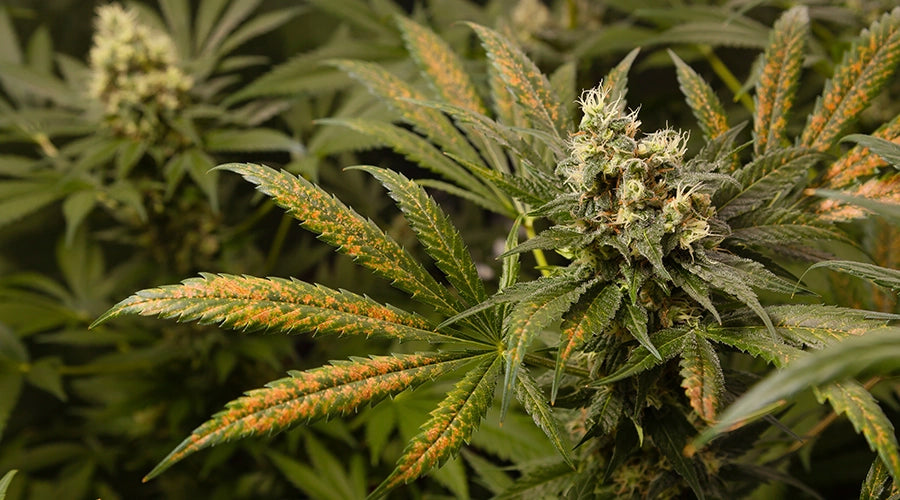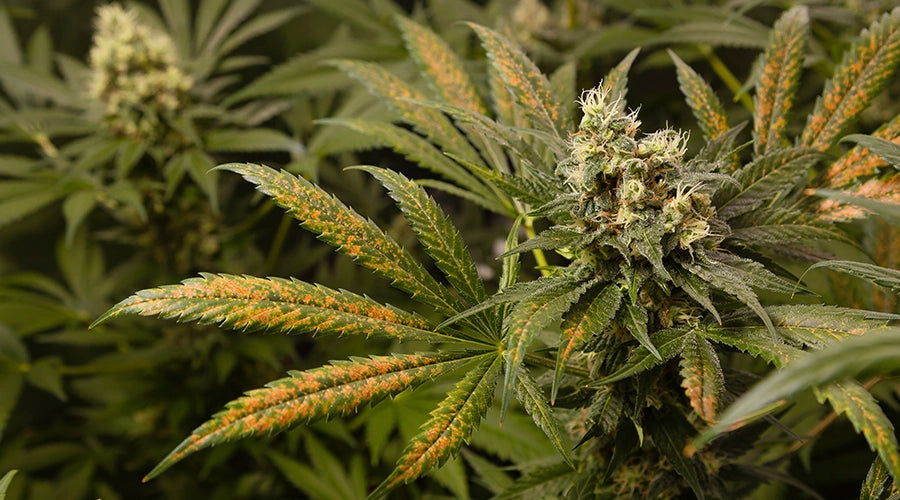
What can I expect with Calcium deficiency in Cannabis?
As you can imagine, calcium deficiency is nothing good. If calmag lockout occurs and this mineral can no longer be absorbed, you can expect a weak, brown-polka dotted, saddened plant that crumples into a pile the longer the deficiency goes unaddressed. As cell walls continue to be built without their support structure, the plant and leaves will become floppier, and unable to properly transpire (the plant equivalent of breathing). Transpiration is how plants exchange carbon dioxide and oxygen, as well as water vapor. Without calcium-enriched cell walls holding the cannabis leaves' stomatae open (the plant equivalent of nostrils) properly, that moisture gets backed up and leads to the breakdown of absorbing the carbon from the air–further starving your already undernourished grow!
Because the same conditions that accompany calcium deficiency, like overly acidic soil, can also cause other nutrients to be locked out, you may see different signs in addition to the tell-tale brown spotting of calcium deficiency, but the unexpected blotching is the most noteworthy signal.
Calcium is only semi mobile–the "skeleton" of the plant can't move around after all, so newer growth tends to show these spots first. Look for discoloration on leaves closer to the top of the plant, and address the issue before it spreads!
Magnesium
Magnesium is another alkaline earth metal, atomic number 12, and right above its cousin calcium on the periodic table. It's the eighth most present material in the earth's crust, and is also a shiny gray, easily cut metal that burns with a bright white flame.
Protip, keep your nutrients away from open fires. The brick red of calcium, white of magnesium, green of copper and more may be beautiful, but it's not worth the hazard.
In a banner year for Sir Humphry Davy, magnesium was also isolated in 1808 via running electricity through compounds containing the element. However its healing effects when mixed with water had been noted before as the still-powerful, unchanged for 400 years Epsom Salts we use on small cuts and sore muscles.
Magnesium is the 11th most concentrated element in the human body, and helps us with muscle relaxation–both smooth (like our intestines) and skeletal (everything else that isn't our heart). In cannabis, it allows for the production of chlorophyll–and is directly responsible for how well the plant can photosynthesize.
Cannabis needs more magnesium in its 'diet' in comparison to other leafy plants, at a rate of between 50 and 75 ppm, depending on its growth stage. Epsom salts have been an older, more primitive method of adding magnesium to soil–as they leach in quickly, but as they're incomplete nutrients and a corrective measure only it's ill-advised to use them by themselves to combat nutrient lockout.
What can I expect with magnesium deficiency?
Because magnesium is so integral to forming chloroplasts, the first thing you'll notice is a fading of the leaf color called chlorosis. Leaves will begin to pale and then yellow around their edges and in between their veins, starting from the oldest bottom leaves and moving upwards. Magnesium is a mobile nutrient, meaning that cannabis can 'pull it' to where a severe deficiency would do the most damage. This pulling doesn't mean any part of your plant is disposable of course–but just like a lizard might shed its tail when it's in danger, your plant is performing hardcore damage control. It's up to you to stay observant so that nothing progresses past the point of no return!
Because calcium and magnesium are such closely related elements, they appear and disappear in the same circumstances. Any environment that causes calcium to be in too high an amount will do the same for magnesium, and anything that causes magnesium to dissapate, like overly acidic soil, will do the same for calcium.
Calmag lockout causes deficiencies in these (and most likely other) nutrients, and leads to a deadly chain of breakdowns as the important metabolic processes are halted in the plants. Corrective measures need to be taken as soon as signs appear!
How can calmag lockout be corrected?
Fixing nutrient lockout is a multistep process! Because lockout is different from a regular deficiency, simply adding more nutrients to the medium will not be an effective treatment.
Your plants will continue to be locked out, the roots may be burned by an overabundance of nutrients in the soil, causing even more damage, and you'll have wasted otherwise effective nutrients that your stressed plants will need later!
Remember, a locked out grow is like a hungry baby at a buffet. All the necessary nutrients are right there for the taking…but they're not in an accessible form!
In cases where lockout is caused by excessive feeding, a thorough flush is necessary to get the medium reset. With soil, watering to the point of over flow and measuring ppm of the drainage is the way to go, while hydro grows can have their pipes cleaned and their water wholly replaced.
Both mediums can benefit from a flush assistant like Lotus Nutrients Carboflush–which neutralizes overabundant compounds to help speed the process.
It's important to remember that correcting lockout will only restore the plant's ability to retake nutrients. Leaves that have totally yellowed or spotted beyond recognition will not be restored.
And, with calmag lockout, and any other nutrient lockout, flushing may only solve part of the issue!
Inspecting your growing environment to prevent further issues is tantamount to keeping your grow thriving.
What can I do to prevent lockout?
To keep calmag lockout from ocurring, or reocurring, you need to make sure your plants aren't stressed.
Nutrient overdose is a common cause. It can be easily solved post-flush by following only the feeding schedule put forward by the manufacturer and no one else. But it's not the only thing to pay attention to!
PH plays a big part in nutrient lockout. A medium that's too acidic or too basic can cause the plant to shut down its nutrient uptake. Test all water that you water with (after adding nutrients when applicable) to make sure it falls within that 5.8-6.2 range.
Check the environment you're growing in as well! If your plants are growing in the kind of peaty soil meant for plants found in bogs, the entire medium will throw off your nutritional balances! Uprooting the plant entirely is obviously a risky process and stressful to you and your cannabis, so make sure you're starting with the right materials from the get go.
Looking for more tips and tricks? You can watch along at our YouTube channel for the answers to frequently asked questions, interviews with our veteran grower cofounders, marijuana mythbusting and more!
You're here for your grow. So are we.
